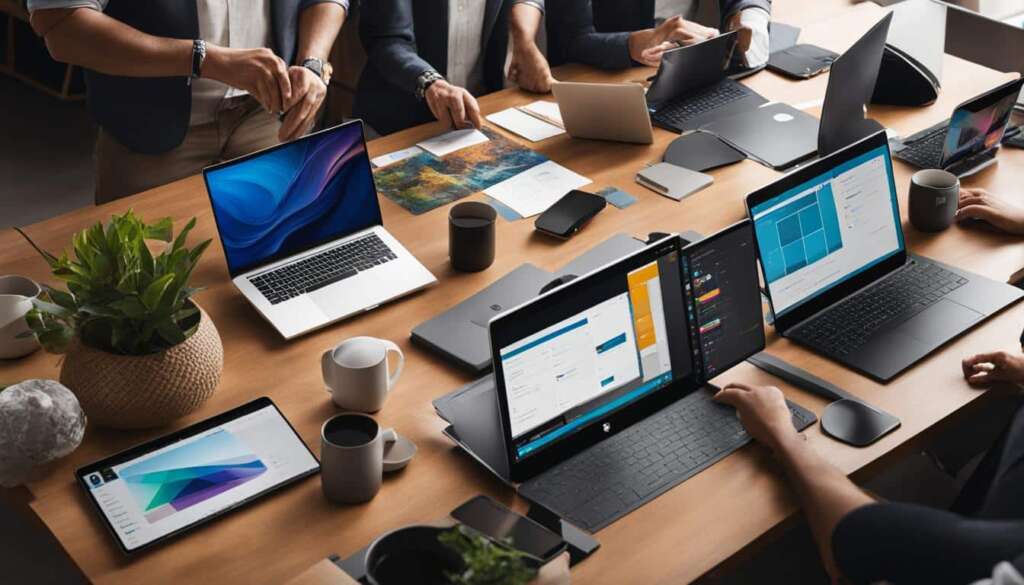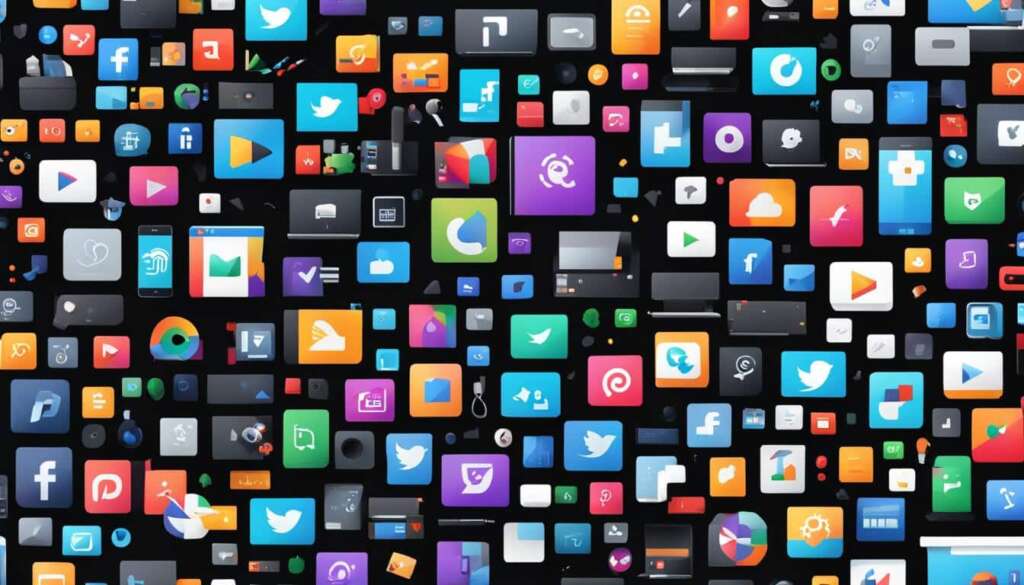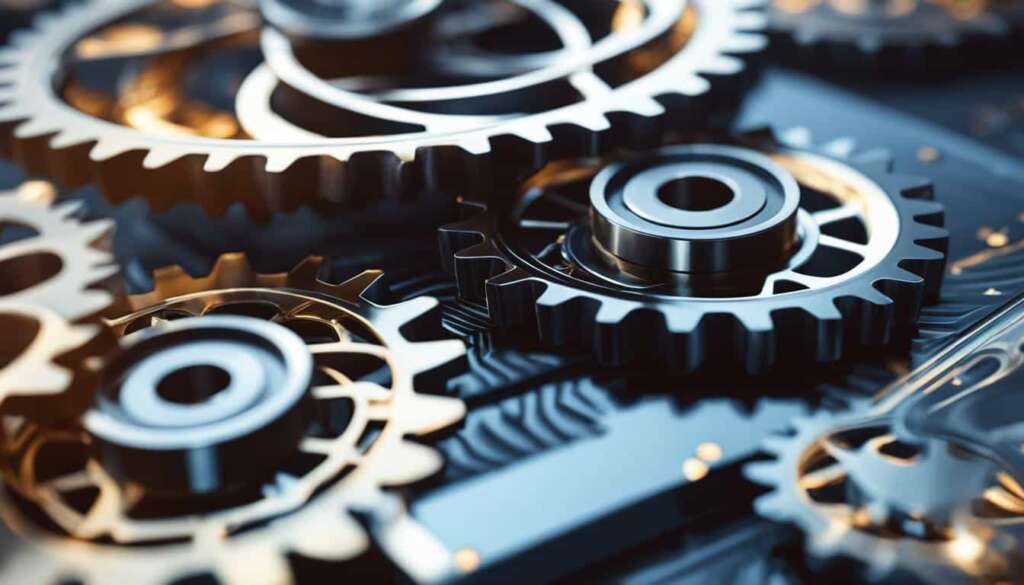Table of Contents
Is your computer crawling at a snail’s pace? Are you left wondering why it’s bogged down and unresponsive? The frustration of a slow computer is all too familiar. But fear not! In this article, we will delve into the underlying causes of a sluggish computer and equip you with the knowledge to breathe new life into it.
There are few things as exasperating as a slow computer. From delayed startup times to lagging applications, it can hinder productivity and test our patience. However, understanding the reasons behind this sluggishness is the first step towards resolving the issue. So, let’s explore the key culprits that contribute to a slow computer.
Key Takeaways:
- Processing (CPU), input/output (IO), and memory (RAM) issues can cause a computer to run slow.
- Checking CPU usage and terminating resource-heavy processes can address CPU issues.
- Monitoring disk activity, closing unnecessary programs, and clearing file caches can resolve IO or disk activity issues.
- Checking available RAM, upgrading if necessary, and optimizing memory usage can fix memory issues.
- Identifying and removing resource-hungry programs, as well as managing startup programs, can improve computer performance.
How to Check for CPU Issues
If your computer is running slow and you suspect CPU issues, there are several steps you can take to check and address the problem. By identifying processes that consume excessive CPU resources and managing them, you can improve your computer’s performance and speed. Here are the steps to follow:
- Use the “top” command: Open the terminal or command prompt and enter the “top” command to view the processes running on your computer. Look for any processes that are using a high percentage of CPU. These processes could be causing your computer to slow down.
- Terminate high CPU processes: If you identify processes that are consuming excessive CPU resources, you can terminate them using the same “top” command. Simply locate the process ID (PID) of the process and enter the kill command followed by the PID to stop the process.
- Check CPU load average: The load average of the CPU indicates how busy the system is and can help determine if the CPU is being overwhelmed. A high load average indicates that there is a heavy load on the CPU, which could be causing your computer to run slow. You can check the load average using system monitoring tools or command-line utilities.
By following these steps, you can effectively check for CPU issues and take appropriate actions to improve your computer’s performance. Remember to monitor your computer regularly and address any CPU-related issues promptly to maintain optimal speed and functionality.
| Step | Description |
|---|---|
| 1 | Use the “top” command to view processes and identify high CPU usage. |
| 2 | Terminate high CPU processes using the “top” command. |
| 3 | Check the CPU load average to determine if the CPU is overwhelmed. |
By systematically checking for CPU issues and taking the necessary steps to address them, you can significantly improve the performance of your computer. Don’t let a slow computer hinder your productivity – follow these guidelines and unlock the full potential of your machine.
Resolving IO or Disk Activity Issues
Is your computer lagging and taking a long time to load? Are you experiencing slow internet on your computer? These could be signs of IO or disk activity issues. When there is congestion on the PCI bus and between different components of your computer, it can cause delays in accessing files and slow down your system. But don’t worry, there are steps you can take to resolve these problems and speed up your computer.
Disk Usage Monitoring
To address IO or disk activity issues, it’s important to start by monitoring your disk usage. You can use tools like Task Manager or Activity Monitor to see which processes or applications are consuming excessive disk resources. By identifying and closing these resource-hungry programs, you can free up disk space and improve disk access.
Clearing File Caches and Freeing up Disk Space
Another way to improve disk activity is by clearing file caches and freeing up disk space. When your computer caches files in memory, it can slow down the system. By clearing these caches and removing unnecessary files, you can optimize your disk access and speed up your computer. You can use disk cleanup tools or manually delete temporary files to achieve this.
Resolving IO or disk activity issues can greatly enhance the performance of your computer. By monitoring disk usage, closing resource-hungry programs, and clearing file caches, you can ensure smoother and faster operation. Don’t let slow disk activity hold you back from enjoying a seamless computing experience.
| Common Causes of IO or Disk Activity Issues | |
|---|---|
| 1 | File transfers or network activity |
| 2 | Resource-hungry programs |
| 3 | Insufficient disk space |
| 4 | Fragmented files |
Fixing Memory Issues
When your computer is running slow, one of the possible culprits could be memory issues. Insufficient RAM can significantly impact the performance of your computer, causing it to lag and respond slowly. Thankfully, there are steps you can take to address these memory issues and optimize your computer’s speed.
To start, it’s essential to check the amount of available RAM on your computer. You can do this using the Task Manager or Activity Monitor. If you consistently notice low available RAM and your computer frequently uses the swap partition, it may be time to consider upgrading your RAM. Increasing your RAM capacity can provide your computer with the necessary resources to handle multiple tasks and applications simultaneously, resulting in improved performance and faster response times.
In addition to upgrading your RAM, there are other measures you can take to optimize memory usage and enhance your computer’s speed. Clearing temporary files can help free up valuable space in your memory, allowing your computer to run more efficiently. You can use built-in disk cleanup tools or third-party software to clean up unnecessary files and optimize your system’s performance.
Another effective way to address memory issues is to close unnecessary programs and browser tabs. Running multiple applications and keeping numerous browser tabs open can consume significant amounts of RAM, slowing down your computer. By closing unused programs and tabs, you can free up memory for more critical tasks, leading to improved overall performance.

| Program | Memory Usage (MB) |
|---|---|
| Google Chrome | 400 |
| Microsoft Word | 150 |
| Adobe Photoshop | 800 |
| Spotify | 200 |
“Upgrading your RAM and optimizing memory usage can significantly improve your computer’s speed and overall performance. Clearing temporary files, closing unnecessary programs and browser tabs are effective ways to free up memory resources and ensure a smoother computing experience.”
Key Takeaways:
- Check available RAM using the Task Manager or Activity Monitor.
- Upgrade your RAM if available memory is consistently low.
- Clear temporary files to free up memory space.
- Close unnecessary programs and browser tabs to optimize memory usage.
Removing Resource-Hungry Programs
Identifying system hogs is essential in order to improve the performance of your computer. System hogs are resource-hungry programs that consume excessive CPU or memory resources, causing your computer to become slow and unresponsive. By identifying and removing these programs, you can free up valuable system resources and optimize the speed and efficiency of your computer.
One way to identify system hogs is by using utilities like “Should I Remove It?”. This tool scans your computer for installed programs and provides ratings and user feedback on their resource usage. Based on this information, you can determine which programs are causing slowdowns and decide if they should be uninstalled.
Another method is to use the Task Manager, which is a built-in tool in Windows that allows you to monitor and manage running processes. By opening the Task Manager and navigating to the Processes tab, you can see a list of currently running programs and their resource usage. Look for programs that have high CPU or memory usage and consider closing or disabling them to free up resources.
Table: Resource-Hungry Programs
| Program Name | CPU Usage | Memory Usage |
|---|---|---|
| Program A | 60% | 500MB |
| Program B | 80% | 1.2GB |
| Program C | 45% | 800MB |
As shown in the table above, Program B has the highest CPU and memory usage, making it a prime candidate for removal or optimization. By identifying and removing such resource-hungry programs, you can reclaim system resources and improve the overall speed and responsiveness of your computer.
Remember to regularly check for new resource-hungry programs, as software installations and updates can introduce new programs that consume excessive resources. By staying vigilant and proactive in managing system hogs, you can ensure that your computer runs smoothly and efficiently.
Managing Startup Programs
When it comes to improving the overall performance of your computer, managing startup programs plays a vital role. Startup programs are the applications and processes that automatically launch when you turn on your computer. These programs can significantly impact the boot time and burden the system resources, causing your computer to run slower than usual. By disabling unnecessary startup apps, you can improve the speed and efficiency of your computer.
There are different methods for managing startup programs depending on your operating system. In Windows, you can use the built-in Task Manager or the System Configuration tool to control which programs launch at startup. In macOS, you can manage startup programs through the Users & Groups preferences. By identifying the programs that you don’t need to start automatically, you can disable them and prevent them from consuming valuable resources during startup.
Disabling startup programs not only helps to speed up your computer’s boot time but also frees up system resources for other tasks. It allows your computer to allocate more memory and processing power to the programs and applications you actively use, resulting in improved overall performance. By taking control of your startup programs, you can optimize your computer’s speed and efficiency.
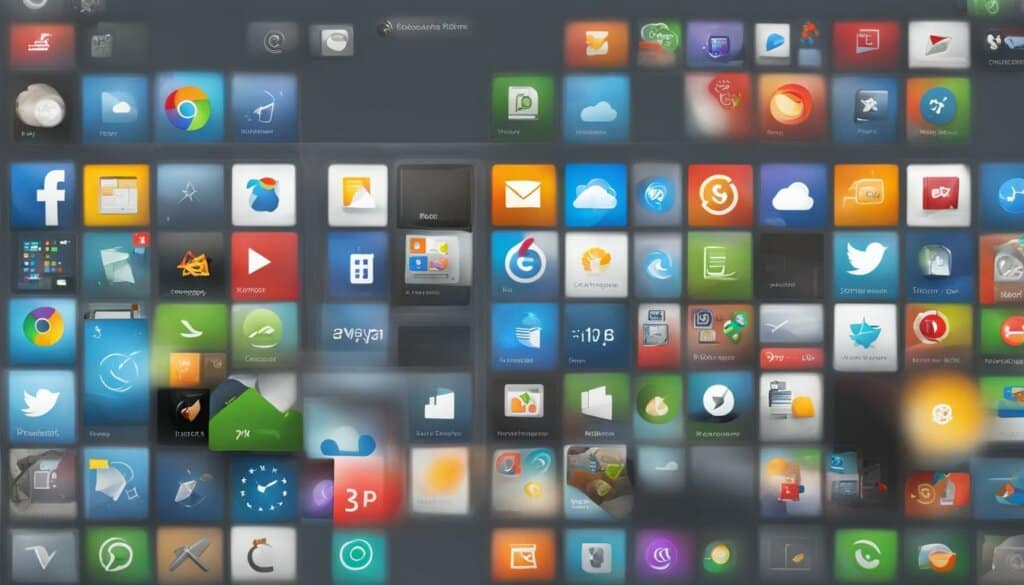
Table: Comparison of Startup Program Management Methods
| Operating System | Method |
|---|---|
| Windows | Task Manager or System Configuration tool |
| macOS | Users & Groups preferences |
Disabling unnecessary startup apps can greatly enhance your computer’s speed and performance. By effectively managing these programs, you can optimize your computer’s resources and ensure a faster, more efficient startup process. Take control of your computer’s startup programs and enjoy a smoother computing experience.
Checking Hardware Components
When your computer is running slow, it’s important to consider the possibility of hardware problems. Faulty hardware can greatly impact the performance of your computer and cause it to slow down. By checking the physical connections of various components and running diagnostic tests, you can ensure that your hardware is functioning optimally.
Start by examining the cables that connect your computer’s components. Make sure they are securely plugged in and not damaged. Loose or faulty connections can lead to data transfer issues and slow down your computer’s performance.
In addition to cables, check the connections of important hardware components such as RAM chips, video cards, sound cards, and network cards. Ensure they are properly seated in their respective slots. If any component is loose or not properly connected, it can cause performance problems.
It’s also beneficial to run a Power-On Self Test (POST) to check for any hardware errors during the computer’s startup process. The POST performs a series of tests on your hardware and alerts you if there are any issues detected. This can help identify the specific hardware component that may be causing the slowdown.
Table: Common Hardware Problems and Solutions
| Hardware Problem | Solution |
|---|---|
| Loose cables or connections | Reconnect and secure all cables and connections |
| Faulty RAM | Replace faulty RAM chips |
| Outdated or incompatible drivers | Update drivers to the latest version or install compatible drivers |
| Overheating | Clean dust from the cooling system and ensure proper ventilation |
| Failing hard drive | Replace the failing hard drive and transfer data |
By regularly checking your hardware components and addressing any issues that arise, you can help maintain the performance and longevity of your computer. Don’t overlook the importance of hardware maintenance as it plays a vital role in ensuring your computer runs smoothly.
Running Virus and Malware Scans
Keeping your computer safe from viruses and malware is essential for maintaining optimal performance. These malicious programs can significantly slow down your computer and compromise your data security. By running regular virus and malware scans with trusted antivirus software, you can detect and eliminate any harmful threats.
To start, make sure you have reliable antivirus software installed on your computer. Popular options include Norton, McAfee, and Malwarebytes. These programs provide comprehensive protection and regularly update their virus definitions to stay ahead of emerging threats.
Once you have installed antivirus software, perform a full system scan to identify any viruses or malware on your computer. This scan will thoroughly examine all files, folders, and programs for any malicious activity. If the scan detects any threats, follow the recommended actions to remove or quarantine them.
Additionally, schedule regular automatic scans to ensure ongoing protection. Set the antivirus software to run scans during periods when you are not actively using the computer, such as overnight or during weekends. This way, the scans will not interrupt your work or leisure time while keeping your computer secure.
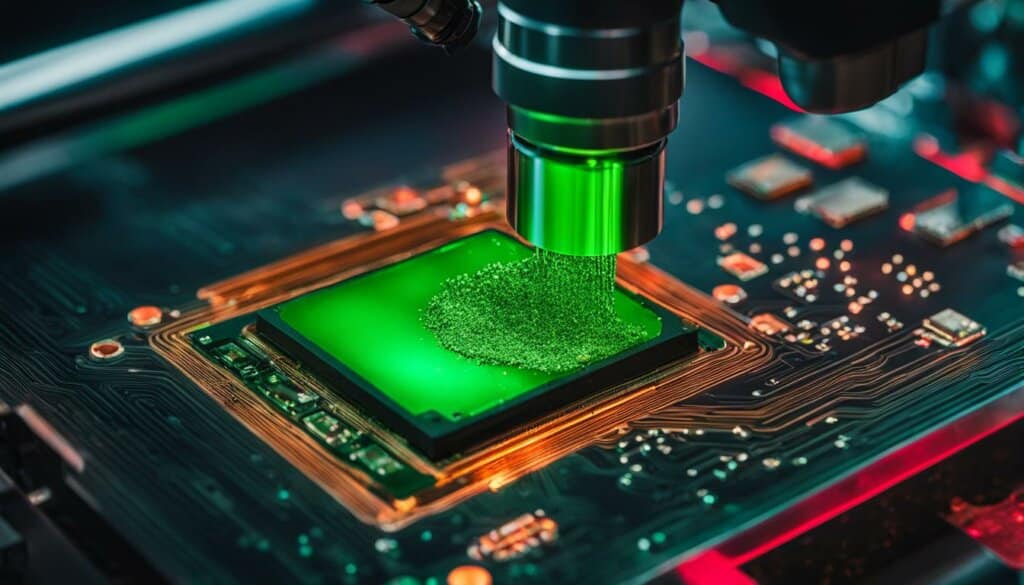
| Benefits of Running Virus and Malware Scans | Actions to Take |
|---|---|
| 1. Enhanced computer performance | Remove or quarantine detected viruses and malware |
| 2. Protection against data loss and theft | Update antivirus software regularly |
| 3. Prevention of unauthorized access to personal information | Schedule automatic scans for ongoing protection |
“Running regular virus and malware scans is like giving your computer a health check-up. It ensures your system is free from harmful intruders, allowing it to perform at its best and keep your data safe.” – Computer Security Expert
Remember to keep your antivirus software up to date by installing the latest updates and patches provided by the software manufacturer. These updates often include bug fixes, performance improvements, and enhanced threat detection capabilities.
In addition to running virus and malware scans, practice safe browsing habits and avoid clicking on suspicious links or downloading files from untrusted sources. These proactive measures, combined with regular scans, will help keep your computer running smoothly and secure from online threats.
Conclusion
Don’t let a slow computer hinder your productivity any longer. By addressing the underlying causes and implementing the right solutions, you can breathe new life into your device and maximize its performance. Whether it’s CPU, disk, or memory issues, resource-hungry programs, or startup management, taking these steps will help you speed up your computer and overcome those frustrating computer performance issues.
Remember, a slow computer doesn’t have to be a permanent problem. With a little effort and the right tools, you can optimize your system and experience a faster and more efficient digital world. So don’t settle for sluggishness – take action today and unlock the full potential of your computer.
Make sure to regularly check your hardware components, run virus and malware scans to keep your system clean, and stay on top of any updates and optimizations. By doing so, you’ll be able to enjoy a smooth and seamless computing experience that allows you to work, browse, and play without any disruptions.
FAQ
Why is my computer running slow?
There are three main issues that can cause a computer to run slow: processing (CPU) issues, input/output (IO) or disk activity issues, and memory (RAM) issues. These issues can degrade the performance of the computer significantly.
How can I check for CPU issues?
You can use the “top” command to see if there are any processes consuming excessive CPU resources. If you find processes that are using a high percentage of CPU, you can terminate them using the same command. Additionally, checking the load average of the CPU can help identify if the CPU is being overwhelmed.
How can I resolve IO or disk activity issues?
Start by checking for any file transfers or network activity that may be causing slowdowns. Monitor disk usage using tools like Task Manager or Activity Monitor, and close any processes or applications consuming excessive disk resources. Clearing file caches and freeing up disk space can also improve disk access and speed up the computer.
What can I do to fix memory issues?
Check the amount of available RAM using Task Manager or Activity Monitor. If it’s consistently low and the computer is using the swap partition frequently, you may need to upgrade your RAM or close unnecessary programs and browser tabs to free up memory. Clearing temporary files and optimizing your computer’s memory usage can also help improve performance.
How do I remove resource-hungry programs?
Use utilities like “Should I Remove It?” to scan your computer for installed programs and determine their resource usage. Based on ratings and user feedback, decide if certain programs should be uninstalled. Additionally, use the Task Manager to check for programs consuming excessive CPU or memory resources and close or disable them to free up resources.
How can I manage startup programs?
In Windows, use the Task Manager or the Startup tab in the System Configuration tool to manage startup programs. In macOS, use the Login Items section in the Users & Groups preferences. By disabling or removing unnecessary programs from the startup list, you can reduce the burden on system resources and improve the overall speed of your computer.
What should I check for hardware components?
Check the physical connections of cables, RAM chips, video cards, sound cards, and network cards to ensure all components are properly connected and functioning. Additionally, check the POST (Power-On Self Test) for any hardware errors that may be causing slowdowns. Running a hardware diagnostic tool can also help identify any failures or issues that need to be addressed.
How do I run virus and malware scans?
Run regular virus and malware scans using trusted antivirus software like Norton, McAfee, or Malwarebytes. These programs are effective in detecting and eliminating malicious programs. By keeping your computer free from viruses and malware, you can ensure optimal performance.
How can I speed up my computer?
By identifying the underlying causes and taking appropriate measures, you can significantly improve your computer’s performance. Whether it’s addressing CPU, disk, or memory issues, removing resource-hungry programs, managing startup programs, checking hardware components, or running virus and malware scans, each step contributes to optimizing your computer’s performance.


